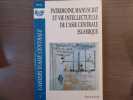4 books for « szuppe maria »Edit
Tamerlan et les Timourides.
<meta charset="utf-8"><span data-mce-fragment="1">Féroce conquérant, à l’instar de Gengis Khan, provenant des confins de l’Asie centrale et de la mythique Samarcande, Amir Timour ou Tamerlan est le fondateur éponyme d’une dynastie majeure : les Timourides (1370-1507). Après sa mort, cette dynastie a dominé l’Est du monde iranien et turco-iranien, et produit l’une des plus brillantes cultures du monde islamique : le fameux « quinzième siècle timouride », combinaison politico-culturelle unique de la tradition turco-mongole et de la tradition iranomusulmane.</span><br data-mce-fragment="1"><br data-mce-fragment="1"><span data-mce-fragment="1">Dans cette synthèse de référence, Maria Szuppe éclairel’originalité de la civilisation timouride : structure de l’État, organisation du pouvoir et de la société, vie économique, religieuse, littéraire et artistique, mais aussi vie quotidienne sont ici racontées au moyen des sources originales, principalement en langue persane, et des recherches les plus récentes dans les domaines historiques, littéraires et archéologiques. Chronologies, cartes et illustrations viennent les compléter.</span> Paris, 2023 Les Belles Lettres 358 p., 14 ill. couleur, 5 cartes, broché. 16 X 24
Neuf
TAMERLAN ET LES TIMOURIDES
BELLES LETTRES EDITIONS -LES-
LIVRE A L’ETAT DE NEUF. EXPEDIE SOUS 3 JOURS OUVRES. NUMERO DE SUIVI COMMUNIQUE AVANT ENVOI, EMBALLAGE RENFORCE. EAN:9782251454726
Christoph U. Werner, Maria Szuppe, Nicolas Michel, Albrecht Fuess (eds)
Reference : 65168
Families, Authority, and the Transmission of Knowledge in the Early Modern Middle East
, Brepols, 2021 Hardback, 334 pages, Size:156 x 234 mm, Illustrations:24 col., 4 maps b/w, Language(s):English, French, German. ISBN 9782503592893.
Summary This volume brings together innovative contributions on the history and nature of families in the early modern Middle East, covering Central Asia, Iran, Ottoman Turkey and the Arab World from the fifteenth to the seventeenth century and beyond. It argues the importance of connecting the key concept of family in its widest possible meaning, whether descent group, lineage, household or dynasty, with the notion of transmission of knowledge, authority, status and power, and develops this idea through a pluridisciplinary and cross-regional approach. Based on primary sources in Arabic, Persian, and Turkish as well as art and material culture, the individual articles detail processes and dynamics of transmission, thus initiating a comparative dialogue. TABLE OF CONTENTS Introduction Religious Lineages and Knowledge Networks Torsten Wollina, Family and Transmission of Knowledge in Mamluk and Early Ottoman Damascus Adam Sabra, Narrating a Lineage's Transition Crisis between Biography and Hagiography. A Case from Ottoman Egypt Alberto Tiburcio, Converts and Polemicists as Bridges in Knowledge Networks. The Case of Safavid Iran Kinship, Status, and Legitimacy Sacha Alsancakli, Warriors, Kings and Caliphs: Questions of Origins and Dynastic Culture in Sixteenth and Seventeenth-Century Kurdistan Syrinx von Hees, Wann f llt der Apfel nicht weit vom Stamm? Zeitpunkte famili rer Amts bertragung in mamlukischer Zeit Nicolas Michel, Families of Cairene Civil Servants, from Mamluk to Ottoman Times (Fifteenth-Sixteenth Centuries) Marriage Alliances and Political Strategies Albrecht Fuess, Sihr and Musahara in Mamluk Royal Relations. Transmitting Power and Enlarging Networks Through In-Law Ties in Pre-Modern Egypt Juliette Dumas, L'histoire du pacha exemplaire mari une sultane extravagante. Genre, politique et r cit intime la cour ottomane au XVIIe si cle Professional Lineages and Transmission Sandra Aube, Family Legacy versus Regional Style: Tracing Three Generations of Woodworkers in Mazandaran (Iran, 1460s to 1500s) Francis Richard, La formation d'un calligraphe dans le monde iranien Managing Households and Family Estates Christoph U. Werner, The Razavi Sayyids of Mashhad: Families within a Family Maria Szuppe, Documenting the Barnabadi Estate: Establishment and Growth of a 'Saintly' Family in Fifteenth to Eighteenth-Century Herat Naofumi Abe, Creating a Family Property in Early Modern Iran: Socioeconomic Activities of Najafquli Khan Dunbuli of Tabriz in the Eighteenth Century
Patrimoine manuscrit et vie intellectuelle de l'Asie centrale islamique.
Tachkent Aix en Provence 1999 In-8 ( 245 X 160 mn ) de 230 pages, broché sous couverture illustrée. Illustrations dans et hors-texte. Très bel exemplaire.
 Write to the booksellers
Write to the booksellers

